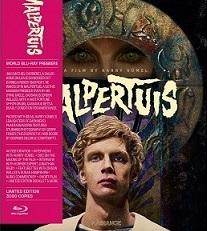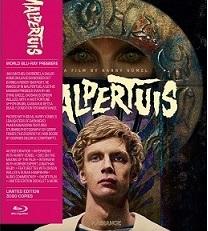Spookiness in ‘Malpertuis,’ ‘Daiei Gothic’
Malpertuis aka The Legend of Doom House (Belgium, 1971, Radiance Films, Blu-ray, NR, 125 min.). A young sailor (Mathieu Carriere as Jan) finds himself trapped in the labyrinthine mansion of his occultist uncle, along with a number of eccentric and mysterious relatives who all seem to be harboring dark secrets. As Jan exits the ship, after all the other sailors, he wanders the seemingly deserted streets of Ghent, looking very much like the sailor in Rainer Werner Fassbinder’s film based on Jean Genet's novel “Querelle,” although that film did not come out until just over a decade later in 1982.
Jan sees his sister Nancy (Susan Hampshire of TV’s “The Forsyte Saga,” “The First Churchills,” “Monarch of the Glen”) and follows her, eventually ending in a crowded club, the Venus Bar, where many of his fellow sailors are getting drunk. There, Jan gets involved in a brawl, is knocked out and awakes in a room in his Uncle Quentin Cassavius’ Malpertuis mansion, a place he never wanted to visit, but now stays at, having missed his ship’s departure.
Made by director Harry Kumel shortly after “Daughters of Darkness,” his ode to sapphic vampires, the film is about aging Cassavius (Orson Welles of “Citizen Kane,” “Touch of Evil”) who, lying on his death bed, collects the bizarre group of people, including servants and relatives, living in his mansion for a reading of his will. The will states that his $526,000-plus fortune will be split among them equally, but in order for them to inherit, they must live out the rest of their lives in Malpertuis and the last two survivors, if a male and a female, must wed. Almost all decide to stay.
The film is adapted from Jean Ray's 1943 novel of the same name, which blends surrealism, Greek mythology and gothic intrigue in a labyrinthine narrative. The mansion’s eccentric inhabitants include a crazy taxidermist (Charles Janssens as Philarette), a spooky light keeper (Jean-Pierre Cassel as Lampernisse), Cassavius’ main henchman (Michel Bouquet as Charles Dideloo) and several enigmatic women. Many, it turns out, harbor dark secrets tied to imprisoned ancient Greek gods.
Interestingly, Hampshire plays three main roles, which seem like three different women, and five in all. In addition to being Nancy, Hampshire is Jan’s love interest Euryale and Alice. Then in the film’s coda, she also plays a nurse and Charlotte.
The film, lensed by Gerry Fisher (“The Exorcist III”), is gorgeous. It uses colors and visual symbolism effectively and is framed in a painterly fashion. The score is by Georges Delerue (“Contempt,” “Day for Night,” “Platoon”).
There are two very different versions of the film on the Blu-ray. The bonus is the 103-minute Cannes cut, which Kumel has disowned. It is a version that was assembled out of Kumel’s control and which played briefly at the festival and gave the film a somewhat bad reputation. The longer second version is Kumel's preferred directors cut, 22 minutes longer and which is reviewed here. Kumel re-cut the film in 2000.
The differences between the two cuts are quite drastic; however, they do not really change the story or the outcome. Things unfold in a very different manner and in a very different order, with the added footage filling in interesting details for a more involving experience in the longer cut. The result is a more mysterious and effective flow that adds substantial eeriness to the bizarre film. Here, the Cannes cut can be viewed in English or in French.
Other extras include an audio commentary by Kumel, who remastered the film for its Blu-ray debut, and assistant director Francoise Levie from 2005; and new interviews with Kumel (19:43) and gothic horror expert Jonathan Rigby, who discusses differences from the book (very good, 26 min.). There also is a good making-of archive from 2005, including an interview with Carriere and the fact that Welles only worked three days for about $1 million (37:22). Outtakes and more comments about Welles, including from the director, are included in “Orson Welles Uncut” (2006; 25:54), also worth viewing. Also from 2006 are interviews with Hampshire (11:43) and Kumel revisiting the locations (4:54). There is a TV piece with author Ray (7:53) and another with Bouquet and Kumel from 1971 (13:36). There also is an 80-page book with new writing by Lucas Balbo, Maria J. Perez Cuervo, David Flint, Willow Catelyn Maclay and Jonathan Owen. Grade: director’s cut 3.25 stars; extras 4 stars
Rating guide: 5 stars = classic; 4 stars = excellent; 3 stars = good; 2 stars = fair; dog = skip it
Daiei Gothic Vol. 2: Japanese Ghost Stories (Japan, 1960-1970, Radiance Films, 3 Blu-rays, NR, 278 min.). The set includes three newly restored films, the first two from director Tokuzo Tanaka (“The Snow Woman”) and the third from director Kimiyoshi Yasuda (“Yokai Monsters”). All three are based on classic stories. The films are reviewed individually.
In “Demon of Mount Oe” (1960, 113 min.), a group of mighty warriors is sent against a demon who steals women from the imperial capital of Kyoto. However, while the demon is more myth than reality, the film does include a satanic bull, a giant spider and a witch. Tanaka starts the film with the warriors arriving at Mount Oe and attacking, but then stops and says that is not what really happened and goes on to tell the story his way.
At its heart, and despite the special effects monsters – done practically – the film is a love story, all set in motion when Kampaku Michinaga Fujiwara (Eitaro Ozawa) eyes the wife of Lord Bizennosuke (Kazuo Hasegawa) and decides he wants her. Michinaga sent Bizennosuke away on a mission and steals his wife (Fujiko Yamamoto as Nagisa) seven years ago. More recently, Michinaga has sent Nagisa to Gen. Minamoto no Yorimitsu (Raizo Ichikawa).
Meanwhile, Bizennosuke has become Shuten Doji, leader of the bandits of Mount Oe, alongside the demon Ibaragi Doji (Sachiko Hidari). Earlier in the film – before Bizennosuke’s backstory flashback – Ibaragi battles Watanabe (Shintaro Katsu) in the sky and he cuts her arm off. Watanabe’s men wait three days to see if the demon returns for her arm; she does.
When soldiers finally attack Mount Oe, they are greeted by balls of fire and rocks from above. Once their leaders are before Shuten Doji, fighting gives way to discussion.
The film comes with a discussion by film historian Tachi Kasuga, who talks about how the film included four major Daiei male stars and two of its female stars (18:54) and a discussion of the film’s glowing blade’s history by Tom Mes (4:04). Grade: film 2.5 stars; extras 2 stars
In Tanaka’s “The Haunted Castle (1969, 82 min.), set in the 14th year of Kyoho (1729), Lord Gyobu (Rokko Toura) desires Lady Sato (Mitsuyo Kamei), the sister of blind monk Lord Matashichirô (Akihisa Toda), and requests her as his concubine, but the monk refuses. Matashi Matashichirô’s family once ruled the area from Saga Castle, before falling out of favor with the emperor, and now survive on a stipend from family retainer Nabeshima, who supplanted Matashichirô.
As a result, Gyobu and Nabeshima kill Matashichirô and have his body thrown into a well, then covered with dirt. The monk’s cat, Tama, brings a bloody piece of his clothing home to Sato and the next morning Sato is notified Nabeshima is seizing her land and home.
Believing that if a cat drinks human blood, it can become a vengeful spirit, Sato kills herself and transfers into Tama, who slinks off to the castle. Soon, Gyobu is seeing Matashichirô’s head on his Go board, two maids are found slain with bloody paw prints leading away from the bodies and Sato’s flying ghost attacks castle residents. (A nice touch has wind blowing only in her hair.)
While Lord Komori (Kojiro Hongo) tries to find and stop the possessed cat, Sayo’s spirit moves on to a couple of women in the castle, one of whom, Lady Otoyo (Naomi Kobayashi), kills two guards in one of the better scenes.
Extras include an interview with J-horror filmmaker Mari Asato, who talks about the film’s good use of light and how the cat was chosen from an audition of 60 cats (17:08) and Tom Mes discussing the tragic life of actress Ikuro Mori (she played Sawanoi in this, her last film), known as the Snake Actress (5:45). Grade: film 4 stars; extras 2.25 stars
Finally, there is “Ghost of Kasane Swamp” (1970, 82 min.), directed by Yasuda. Blind money lender Soetsu (Kenjiro Ishiyama) goes to collect from samurai Fukami (Saburo Date), who is busy having sex with his maid and says go ask his wife Sawano (Mitsuko Tanaka) for payment, knowing she will probably offer Soetsu her body as she has no money. Despite it being his idea, Fukami kills both Soetsu and his wife. This sets up a curse that falls upon the next generation.
Both Soetsu’s daughter Oshiga (Maya Kitajima) and Fukami’s son Shingoro (Ritsu Ishiyama) seek to find Soetsu’s gold. Oshiga wants 40 ryo to buy the debt owed by the madam of the brothel she works in. She finds the gold, buys the debt and becomes the brothel’s new madam. Prior, two friends of Shingoro – Jinso (Takumi Shinjo) and Senta (Kazue Tamaki) -- were paid by Fukami to dump the two corpses in the swamp.
Their ghosts bother Fukami, who dies and the police say his death was unnatural. Jinso and Senta, while ransacking Soetsu’s house for his gold, rape his daughter Oson (Matsuko Oka) and sell her into prostitution. Shingoro, asked by Jinso and Senta to help burn down the brothel, is seduced by Oshiga. While Oshiga and Singoro seem to have everything they need, a series of human and ghostly events lead to a violent and bloody retribution for everyone. This is a film with no good people in it.
This actually was the second time Yasuda had filmed the swamp ghost story – the first time lacked the sex scenes, as Norio Tsuruta, the “Father of J-horror” points out in his discussion of the film (17:36). There also is a scene-specific audio commentary by Lindsay Nelson and Zack Davisson’s discussion of the story’s history and evolution over time (12:16). Grade: film and extras 2.5 stars
The set also comes with an 80-page book with new writing by Amber T, Jasper Sharp and Tom Mes; archival writing by Daniel O’Neill; and original ghost stories “The Goblin of Oeyama” and “The Vampire Cat.”
Spawn (1997, Arrow Video, 2 4K Ultra HD discs or 2 Blu-rays, R and PG-13, 98 and 96 min.). Al Simmons (Michael Jai White of “Black Dynamite,” “The Dark Knight”) is an assassin for a group led by Jason Wynn (Michael Sheen of “The Departed,” “Apocalypse Now”), but he is upset that his latest kill in Hong Kong came with28 additional deaths of innocents. Simmons therefore decides to quit, but Wynn talks him into one more job at a North Korean biochemical plant. Wynn needs the formula the plant has been working on for his Heat-16 bio weapon that he is making for the Clown (John Leguizamo of “Moulin Rouge,” “Romeo + Juliet”), who is working for the Devil Malebolgia (voiced by Frank Welker).
During the op, co-agent Jessica Priest (Melinda Clarke of TV’s “Nikita,” “The O.C.”) shoots Simmons and then Wynn sets him on fire. Simmons does not fully die though and wakes disfigured in Rat City a full five years later. He learns that his fiancée Wanda (Theresa Randle of two “Bad Boys” films) has married former bodyguard Terry Fitzgerald (D.B. Sweeney of “The Cutting Edge”), now Flynn’s publicity director, and they have a child. Simmons’ dog still recognizes him.
Down in Rat City, Simmons has become Spawn, equipped with necroflesh armor and other gadgets that work through his mind, after he has agreed to lead Malebolgia’s armies from hell against heaven. Of course, he wants some revenge on Wynn first.
Spawn is based on Todd McFarlane’s (“The Amazing Spider-Man”) comic book. What ruins the film for me is the vile Clown character, with his most distasteful actions and comments. And, of course, Clown turns into large, grotesque Violator. Also, the film is overblown with special effects, particularly the digital ones. Director Mark A.Z. Dippé had a special effects background.
The film comes in both the R-rated director’s cut and the PG-13 theatrical cut. The director’s cut has all the extras, including a new audio commentary by comic book expert/podcast host Dave Baxter and a 1998 commentary by McFarlane, director Dippé, Clint Goldman and Steve Williams. There are five new interviews, with White (16:20; says wearing the suit was like being in hell), actors Clarke and Sweeney (16:48; done separately), animatronic creature and special makeup effects artists Howard Berger and Greg Nicotero (20:14; very good), editor Michael Knue (16:42) and music supervisor Happy Walters (10:24).
Also, McFarlane talks about the movie versus the comics in a 1998 interview (19:37); plus there are an archival making-of feature (21:58); an animated movie preview (1:44); five scene-to-storyboard comparisons; three McFarlane sketches (4 secs.); a 7-part Spawn concept and sketch gallery; a double-sided foldout poster; and an illustrated collector’s booklet with new writing on the film by John Torrani. Grade: film 2 stars; extras 4 stars
About this blog:

My music review column, Playback, first ran in February 1972 in The Herald newspapers of Paddock Publications in Arlington Heights, IL. It moved to The Camden Herald in 1977 and to The Courier Gazette in 1978, where it was joined by my home video reviews in 1993. The columns ran on VillageSoup for awhile, but now have this new home. I worked at the Courier Gazette for 29 years, half that time as Sports Editor. Recently, I was a selectman in Owls Head for nine years.




























